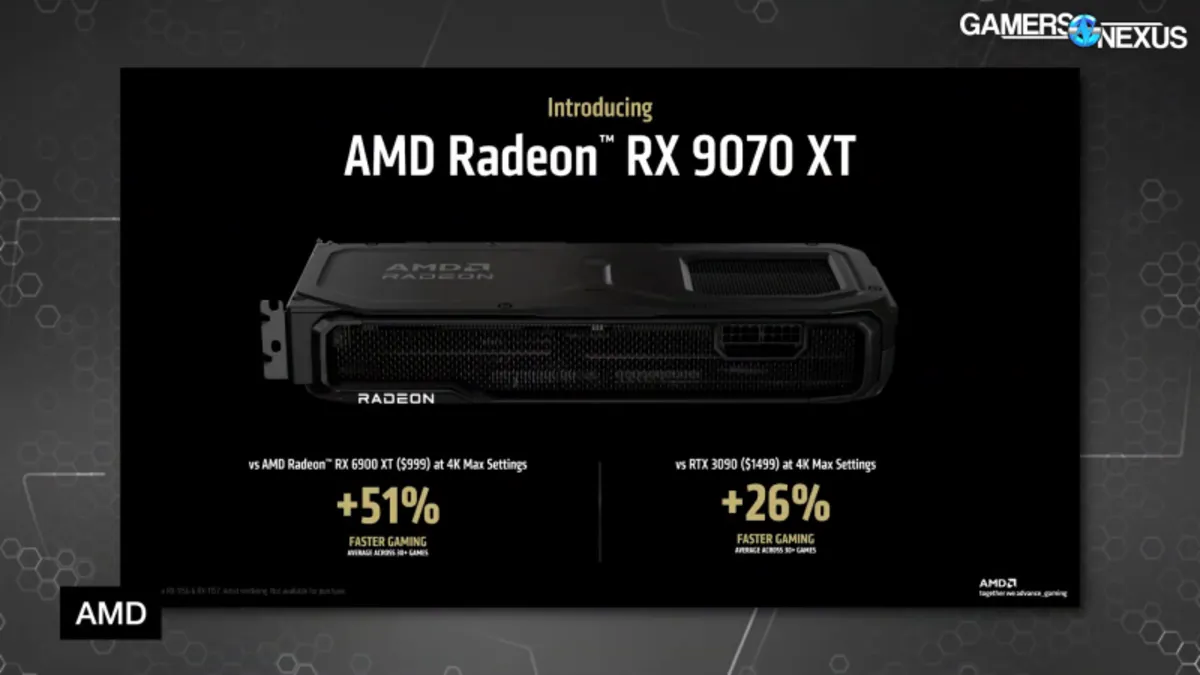
The AMD RX 9070 series is set to challenge NVIDIA’s RTX 5070 lineup, with the RX 9070 XT directly competing against the 5070 Ti. In a bold move, AMD has revamped its naming scheme, moving away from previous iterations such as R9 270, R7 370, RX 480, and more. This shift indicates AMD's intent to modernize its branding strategy as it prepares for the next generation of graphics cards. The anticipation surrounding the RX 9070 series raises questions about future naming conventions, especially as AMD approaches the potential milestone of a "10,080 Ti…XT."
When it comes to pricing, the RX 9070 and RX 9070 XT are positioned just $50 apart, which could result in market cannibalization. A glance at AMD’s previous pricing reveals a trend of rapid fluctuations and adjustments. For context, the RX 7800 XT is available for approximately $500 to $530, while the RX 7900 GRE has hovered around $550 but has faced stock shortages. The RX 7900 XT, which once commanded around $680, is now harder to find. The RX 7900 XTX had its price range from $800 to $930 before its initial $1,000 launch price. Notably, the RX 7900 XT received a review titled “AMD’s Greedy Upsell” due to its pricing strategy, which AMD later adjusted significantly, showcasing their responsiveness to market dynamics.
According to AMD's spec sheet, the RX 9070 features 56 Compute Units (CUs), while the RX 9070 XT boasts 64 CUs—a 14% increase. This architectural choice mirrors previous AMD splits, such as those seen with the Vega series, but with notable advancements. AMD's decision to limit the number of CUs reflects a strategic focus on appealing to the mid-range market, where performance is optimized without excessively inflating production costs.
Both cards are equipped with hardware ray tracing accelerators, matching their CU counts, and boast AMD's "AI accelerators" at 112 and 128 units, respectively. The RX 9070 XT, with its higher power budget, achieves a boost clock of 2.97 GHz compared to the 2.52 GHz of the RX 9070. Both variants come with 16 GB of GDDR6 memory operating at 20 Gbps, and their board power is set at 220W and 304W, respectively, allowing for potential overclocking through partner enhancements.
The RDNA 4 architecture, utilized in both the RX 9070 and RX 9070 XT, marks a significant leap forward. Featuring a die size of 356.5mm² and housing 53.9 billion transistors, this architecture is built on a 4nm process node. AMD emphasizes its renewed focus on ray tracing performance, claiming significant improvements in ray intersection rates and traversal speeds. This is crucial as AMD aims to close the performance gap with NVIDIA in ray tracing scenarios, an area where it has historically lagged.
Key enhancements include a doubling of ray accelerators and a transition to an 8-wide Bounding Volume Hierarchy (BVH) structure, which reduces overhead during geometry intersection probing. AMD’s commitment to optimizing ray tracing performance is designed to enable better performance in games that rely heavily on this technology.
AMD has released initial performance claims for both the RX 9070 and RX 9070 XT. The RX 9070 is marketed as achieving a 26% performance increase over the RTX 3080 and 38% over the 6800 XT. In non-ray tracing scenarios, the RX 9070 is expected to outperform the RX 7900 GRE by 21% at 4K/Ultra settings. For ray tracing, AMD claims improvements of up to 34%, showcasing its commitment to enhancing this aspect of gaming performance.
On the other hand, the RX 9070 XT claims a remarkable 51% uplift over the 6900 XT and a 26% increase over the RTX 3090. Against the RX 7900 GRE, the RX 9070 XT shows a substantial 42% improvement, particularly excelling in ray tracing performance in demanding titles like Cyberpunk 2077.
As the launch date for the RX 9070 series approaches, the focus will remain on pricing and performance. AMD has an opportunity to capitalize on NVIDIA's missteps and regain market share, which currently sits at a low of around 10%. The company must execute its strategy effectively to leverage the positive momentum and consumer interest. We anticipate third-party benchmarks shortly, which will provide clearer insights into how these new graphics cards perform in real-world scenarios.
Stay tuned for our upcoming reviews, where we will dive deeper into the performance metrics, pricing strategies, and overall value of AMD's RX 9070 series in comparison to NVIDIA's offerings.